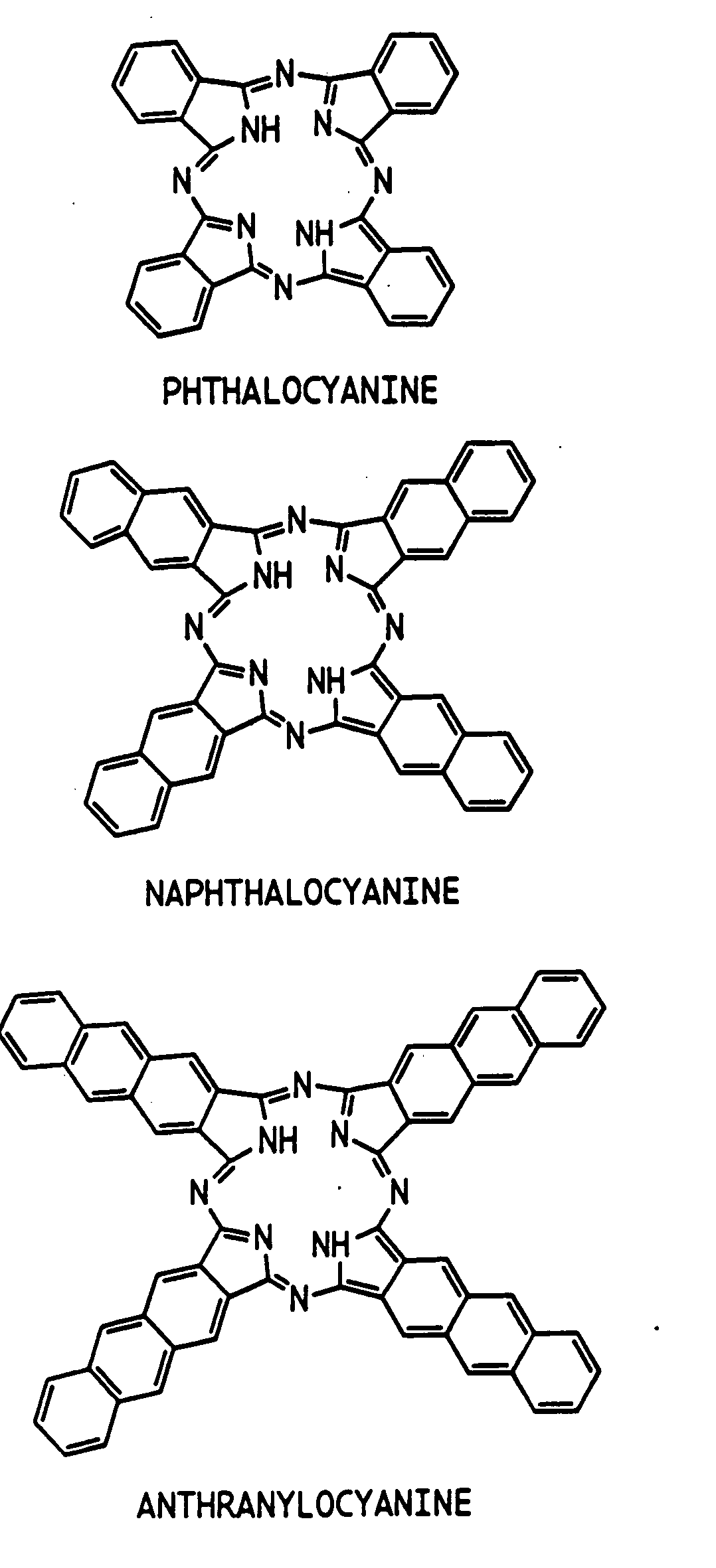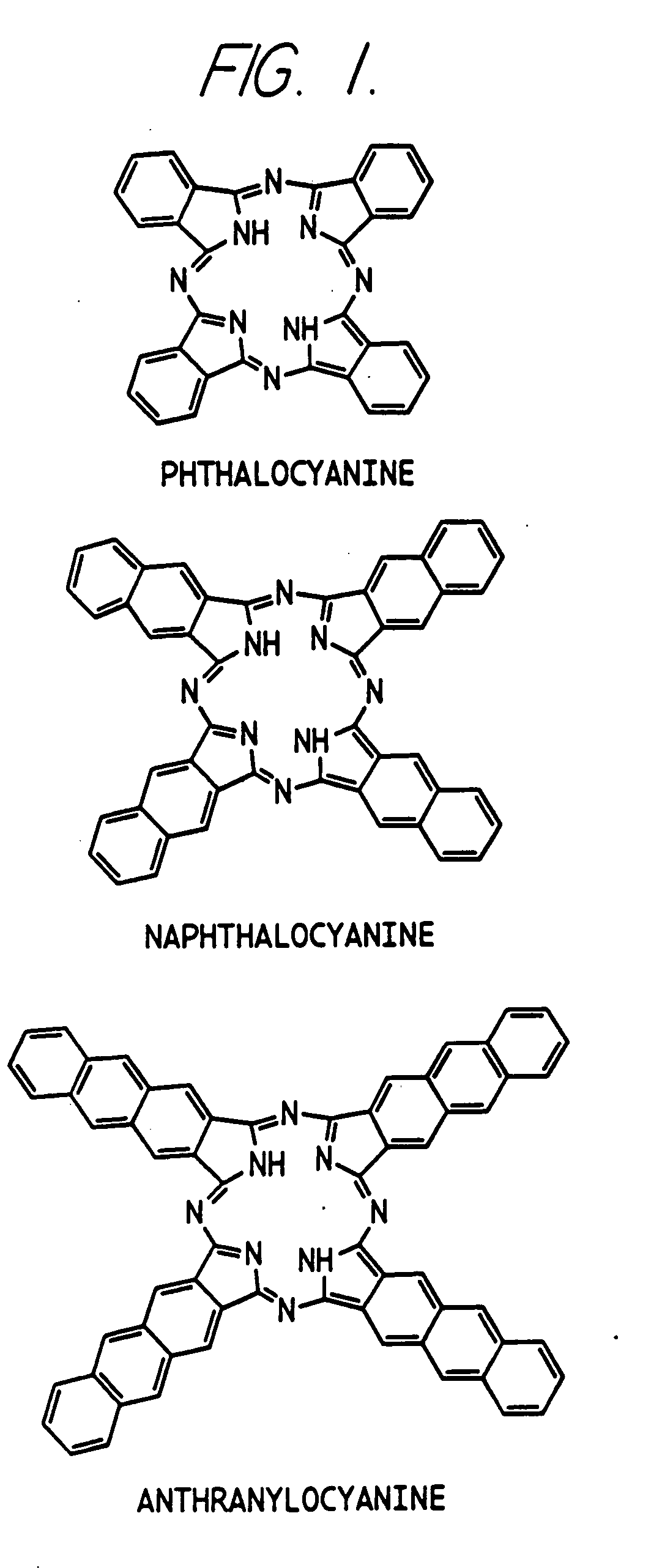Hybrid phthalocyanine derivatives and their uses
a technology of phthalocyanine and derivatives, applied in the field of synthesis of novel dyes and labels, can solve the problems of less popular use of radionucleotides in immunoassays, inaccurate quantitation of target ligands, and inability to quantify target ligands, so as to maximize the fluorescence intensities of dye molecules and minimize the effect of fluorescence quenching
- Summary
- Abstract
- Description
- Claims
- Application Information
AI Technical Summary
Benefits of technology
Problems solved by technology
Method used
Image
Examples
example 1
Synthesis of Silicon Phthalocyanine Dihydroxide SiPc(OH)2
[0109] A suspension of silicon phthalocyanine dichloride (1.83 g, 3.0 mmol) in pyridine (50 ml) and water (50 ml) was refluxed with stirring on an oil bath at 120° C. for 18 hours. After cooling the dark blue solid product was filtered and the residue was washed with water (10 ml), acetone (5 ml) and then dried under vacuum to afford 1.71 g of the title compound.
example 2
Synthesis of Silicon Phthalocyanine bis(trihexylsilyloxide) (hereinafter sometimes referred to as PcSi trihexyl)
[0110] A suspension of silicon phthalocyanine dihydroxide (115 mg, 0.2 mmol) in anhydrous pyridine (11 ml) containing chlorotrihexylsilane (733 μL, 2.0 mmol) was refluxed on an oil bath at 130° C. for 5 hours. The resulting purple solution was allowed to cool and was evaporated. The resulting slurry was treated with ice-cold hexane (2 ml) and the dark blue solid product was filtered, washed with ice-cold hexane (2 ml) and was dried under vacuum to yield 249 mg of crude product. The crude product in chloroform was purified on an Alumina column (Activity 1) equilibrated in hexane and the product was eluted with hexane / toluene (2 / 1, v / v) as a bright blue band. The solvent containing the product was evaporated to yield 69 mg of the title compound with a melting point of (mp) 171° C. (literature mp is 175° C.).
example 3
Synthesis of Silicon Phthalocyanine bis[(10-carbomethoxydecyl)dimethylsilyloxidel (Hereinafter sometimes referred to as PcSi methyl ester)
[0111] To a suspension of silicon phthalocyanine dihydroxide (115 mg, 0.2 mmol) in anhydrous pyridine (11 ml) was added (10-carbomethoxydecyl)dimethylchlorosilane (586 mg, 2 mmol) and the mixture was refluxed with stirring on an oil bath at 130° C. for 5 hours. The dark blue solution was allowed to cool and the solvent was evaporated. The residue was purified on a Silica gel 60 Å column equilibrated in hexane and the product eluted slowly as a blue band with toluene. The toluene fraction containing product was evaporated, hexane (10 ml) was added to the residue and the blue product was filtered, washed with hexane and dried to afford 105 mg of the title compound.
PUM
| Property | Measurement | Unit |
|---|---|---|
| size | aaaaa | aaaaa |
| size | aaaaa | aaaaa |
| size | aaaaa | aaaaa |
Abstract
Description
Claims
Application Information
 Login to View More
Login to View More - R&D
- Intellectual Property
- Life Sciences
- Materials
- Tech Scout
- Unparalleled Data Quality
- Higher Quality Content
- 60% Fewer Hallucinations
Browse by: Latest US Patents, China's latest patents, Technical Efficacy Thesaurus, Application Domain, Technology Topic, Popular Technical Reports.
© 2025 PatSnap. All rights reserved.Legal|Privacy policy|Modern Slavery Act Transparency Statement|Sitemap|About US| Contact US: help@patsnap.com



